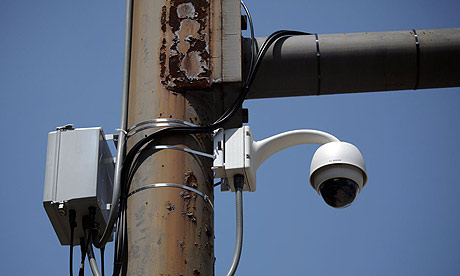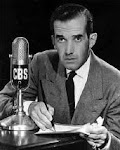
A security camera is mounted on a utility pole in Lancaster, Pennsylvania. Photograph: Carolyn Kaster/AP
Horses drawing buggies regularly clop down the roads approaching Lancaster, Pennsylvania a peaceful city in the heart of Amish country that had only three murders last year and relatively low crime.
But if the community sounds reminiscent of the past, it also has some distinctly modern technology: 165 surveillance cameras that will keep watch over thousands of residents around the clock.
When it is complete, the surveillance system will be bigger than those in large cities such as Philadelphia, San Francisco and Boston. And the fact that it will be monitored by ordinary citizens has raised privacy concerns.
"They are using fear to sell the cameras as much as possible," said Charlie Crystle, a member of a fledgling citizens group that opposes the cameras and is trying to raise public awareness about them. "There's just a huge potential for personal and political abuse."
Officials in the city of 54,000 say the cameras have deterred crimes and helped solve them.
The white, domed cameras sit atop utility poles in public spaces, business districts and some residential areas. They are monitored 18 to 24 hours a day by employees of the Lancaster Community Safety Coalition, a non-profit board with workers who report suspected crimes to police.
Lancaster is the seat of Lancaster county, a popular and peaceful tourist destination known for having one of the nation's largest Amish populations. Horses and buggies are common on surrounding roads.
The safety coalition, directed by city councilman Joseph Morales, screens prospective monitors and provides training about racial profiling and how to spot trouble. The group has seven monitors, all paid. The coalition does not release their names.
Monitors sit in a room with two large plasma screens and six smaller ones, each divided into views of different cameras. A joystick allows them to zoom in or move the cameras if they see something unusual. If they do, they call police.
"What they are typically seeing is people in their everyday life going through their business," Morales said. "They're looking for anything out of the ordinary."
A special commission recommended the $2.7m (£1.6m) camera system in 2001 in response to a spike in some crimes. Police chief Keith Sadler strongly supports having citizens monitor the cameras because he does not have the manpower to do it with a force of 159 officers, about 20 fewer than two years ago.
"In this economy, nobody has the luxury to take cops off the street," Sadler said. "You are probably watched more by non-police agencies than you are by us."
Lancaster has seen some declines in property crimes since the cameras went up, but those numbers have fluctuated — along with the totals for violent crimes.
Despite inconclusive statistical evidence, police and the commission say the cameras are providing officers with a new tool. Last year, commission workers called police 492 times and provided video to police 305 times. That work led to 82 arrests and 86 citations, as well as 18 charges pending.
Police also credit the cameras with helping to solve a murder in which a man was shot outside a restaurant and the shooting was caught on tape.
Other small cities have also invested in surveillance cameras, though not as heavily as Lancaster.
In Wilmington, Delaware, the city of about 73,000 developed a network of 21 publicly owned cameras and networked them with more than 200 private cameras owned by businesses.
That city also has 37 neighbourhood cameras, and the combined system is monitored by a non-profit group, which refers calls to the police.
Wilkes-Barre, a north-eastern Pennsylvania city even smaller than Lancaster, is planning to install 150 cameras this year, also monitored by a non-profit.
Some research has cast doubt on just how much surveillance systems reduce crime.
A January study by the University of California found that cameras did not reduce homicide in San Francisco but did help reduce the number of burglaries and some thefts. A New York University study found that cameras did not do much to deter crime in some public housing projects.
Those findings and others are part of why Crystle and other critics do not think the effort is worth the risk in a small town like Lancaster.
He also points to examples such as Cambridge, Massachusetts, where officials decided in February against adding surveillance cameras because of privacy concerns.
Crystle and others in Lancaster say they have done nothing to warrant being watched. Nick Boots, who owns a barber shop near a camera, said he thinks the city is using fear to gain support for the cameras.
"Through the fear of the perceived threat, people are willing to give up certain rights," Boots said. "You got to think of Lancaster now being like an open-air prison. Who's the warden?"
Others praise the project, including Francisco Cruz, 65, owner of Cruz Barber Shop, who said he's seen less drug dealing and fewer prostitutes outside his shop since cameras went up.
"I don't care if they put one right here in the shop," Cruz said.
The American Civil Liberties Union also objects to the project, especially since it covers the entire city — not just high-crime areas.
"When you have a blanket network of surveillance, you are no longer about solving crime," said ACLU attorney Mary Catherine Roper, citing studies that show cameras mainly help solve just small crimes. "Now you're talking about a surveillance community."


















That article is so much intersting and so much informative also. I get many information about the security camera with the help of this article. For the more information viisit on www(dot)sunsecurity(dot)com.
ReplyDeleteColor Security Camera